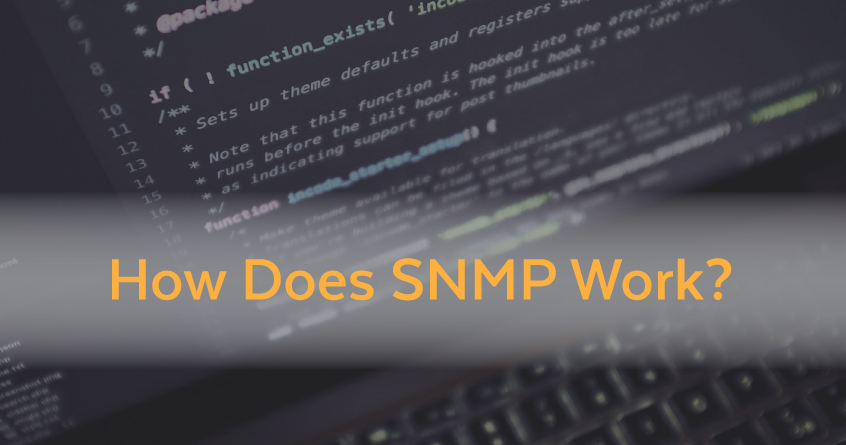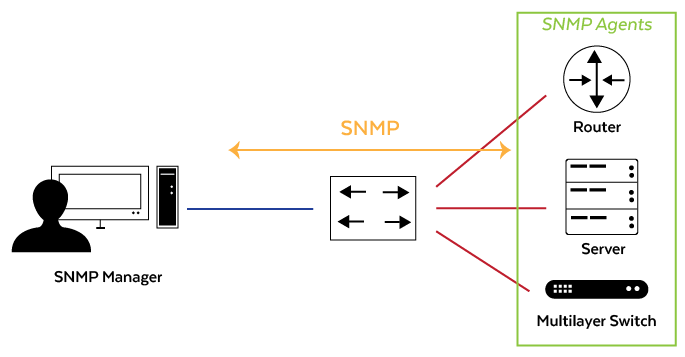SNMP stands for Simple Network Management Protocol, which is an internet standard used to manage networks. It’s a protocol for collecting and managing data from network devices. Enterprises use it to monitor the performance of their IT systems. It’s the most common means of communication between devices on a network.
If you’ve ever been tasked with managing a network, then you know it can be daunting. There are so many different components — from routers and switches to firewalls and load balancers — and each of these pieces needs to be configured properly for your network to function at peak performance. SNMP makes it possible for administrators to configure their equipment effectively and keep track of its status.
SNMP also allows administrators to monitor the traffic flowing through their systems and identify any potential security breaches. So, let’s look at how SNMP works and how you can make it work for your business.
So, What Is SNMP, and What Is It Used For?
SNMP is an internet protocol for monitoring and managing networks. Organizations of all types use it to monitor the health and performance of their IT systems. It will also monitor network-connected devices such as servers or routers. It also allows administrators to poll the status of these devices at any time to determine whether they are working properly or not.
So generally, businesses and enterprises use SNMP to monitor their IT systems, including network equipment such as switches and printers. This helps them make sure that everything works properly at all times so that users can access services without any problems whatsoever.
How Does it Work?
SNMP is a simple network management protocol that allows administrators to monitor and manage network-attached devices. It works by sending messages between the network device and the system running the SNMP agent. The agent then translates these messages into a standard format, which can be read by software on the host computer. The agent then sends these translated messages back to the SNMP manager.
A management station (i.e., a computer) then processes this information, and the computer typically displays it in some way for example, on a web interface that allows users to see what’s going on with their devices at any given time.
The manager uses this information to generate reports, which they send to administrators who need to know about any problems or issues with their network devices.
What Are the Components of SNMP?
The components of SNMP are:
1. SNMP Manager
The SNMP manager is a software application that runs on a computer and manages operations between an agent and a network management system. Agents gather information from the managed device or devices, store it in an MIB, and send it to the SNMP manager.
2. SNMP Agent
An agent is software that collects information from one or more networked devices that an SNMP manager is running. The agent stores this information in an MIB, which the manager can access through queries. Agents can also run on any computer connected to a managed device or devices.
3. Management Device
A management device is any hardware or software device that can monitor and manage network traffic on a local area network (LAN). This can include routers, switches, hubs, printers, firewalls, etc.
4. Management Information Base
MIB is the database that stores information about an object in the SNMP system. Each object has a unique identifier called its Object Identifier (OID). The OID identifies an object within the MIB and each OID has an associated value that represents the state or status of an object in the MIB.
An MIB is a database containing information about networked devices, including their configuration parameters and performance statistics.
5. Object Identifier
An OID is a unique number assigned to each object defined in an MIB. These objects allow users to gather specific information about network nodes by referencing their OID numbers.
What Are the Basic SNMP Commands?
To manage your network, you need to know how to use SNMP. Below is a table of the most important SNMP commands:
What a SNMP Command Does
| Get | Retrieves information by sending a request (to the SNMP agent) for data from a particular device on the network |
| Response | SNMP agent retrieves and sends a response back from the device that matches the request |
| GetNext | Retrieves data from a specific object in the MIB hierarchy by sending a request for data from a particular device on the network and gets any additional information about the requested object |
| Trap | Sends an alert about an event that has occurred on the network or is about to occur (like when there’s an outage)
Ordinarily, this occurs when something happens on the managed device that was not anticipated by either user or system administration action |
| Inform | This command works like Trap, only that it sends more detailed information about an object in your system |
| Set | Allows you to change configuration settings on devices in your system |
SNMP Protocol Versions
In this section, you’ll find the three versions of SNMP: v1, v2, and v3.
- SNMP v1 is the original version of SNMP. Released around 1988, it was a standard way to manage network devices. The problem with v1 is that it’s not very secure, so it’s not used much anymore.
- SNMP v2, released around 1996, was a more secure version of v1. It uses encryption to protect communications between network devices and management stations (the computers used to manage the network). It’s still widely used today but doesn’t have the security or scalability needed for modern networks.
- The third and newest version of SNMP, SNMP v3, was released around 1998. It includes more advanced security features like authentication, encryption, and data integrity checks, along with a set of management standards that make it easier to manage devices on large networks.
Why Do You Need SNMP Monitoring Tools?
SNMP is the protocol that allows you to monitor your network in real time. It allows you to see what’s going on with your hardware, software, and network connectivity.
Administrators can use this information to make informed decisions about how their networks perform and what needs to be fixed if any problems arise.
It’s the language that lets you ask your router, “Hey, how’s it going?”
It’s also the language that lets you tell your router, “Hey, I’m having some trouble with this connection. Can we do something about it?”
In other words, SNMP is what allows us to talk to our routers and other network devices. It helps us ensure they’re working correctly and efficiently, and when they aren’t, it gives us the power to fix them.
Therefore, SNMP monitoring tools are a crucial part of any business or enterprise’s IT infrastructure because they help you:
- Avoid downtime by identifying issues before they become problems.
- Reduce costs by identifying inefficiencies and waste in your systems and processes so that you can make more informed decisions about budgeting and resource allocation.
- Improve customer satisfaction by giving them quick access to information about their service, such as whether or not it has been restored following an outage or when they can expect a shipment to arrive after ordering online (this is especially important for e-commerce sites).
How Planet Technology USA Can Help You
SNMP is a powerful protocol that allows you to control your network devices using a single dashboard. The SNMP protocol embeds in many network devices such as routers, servers, switches, and more.
At Planet Technology USA, we know that a strong network is the foundation of your business. That’s why we offer top-quality PoE switches and other last-mile networking devices that can help you keep your operations running smoothly and efficiently.
We can help you make the most of your SNMP implementation with our products and services. If you want to learn more about our products, visit our website today.

